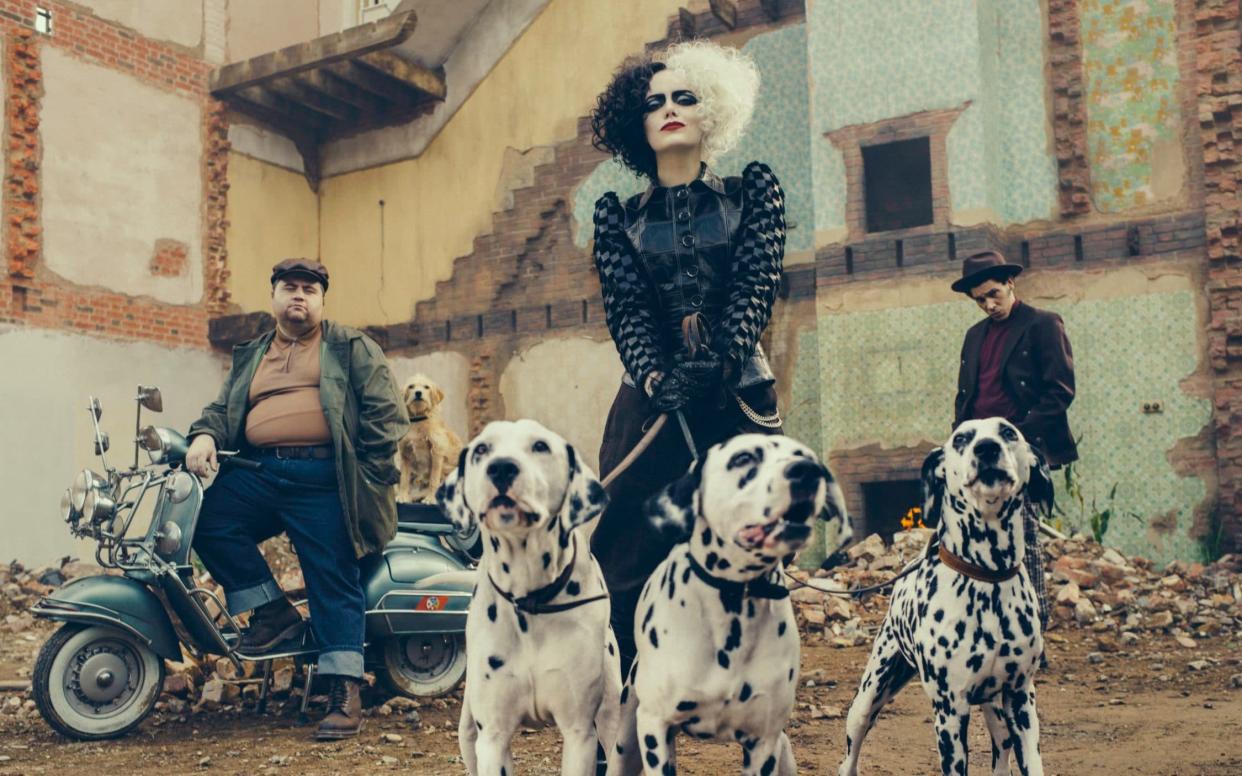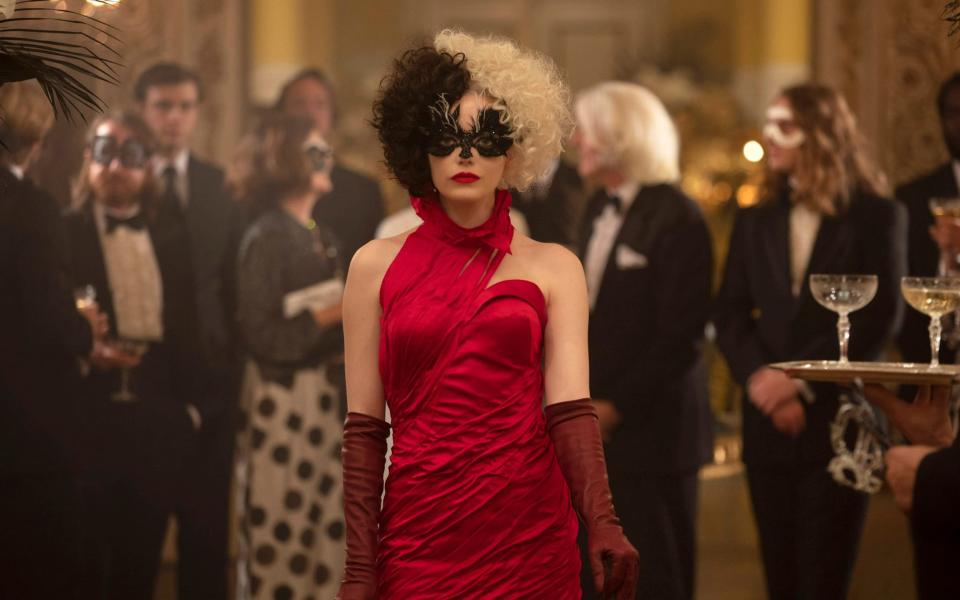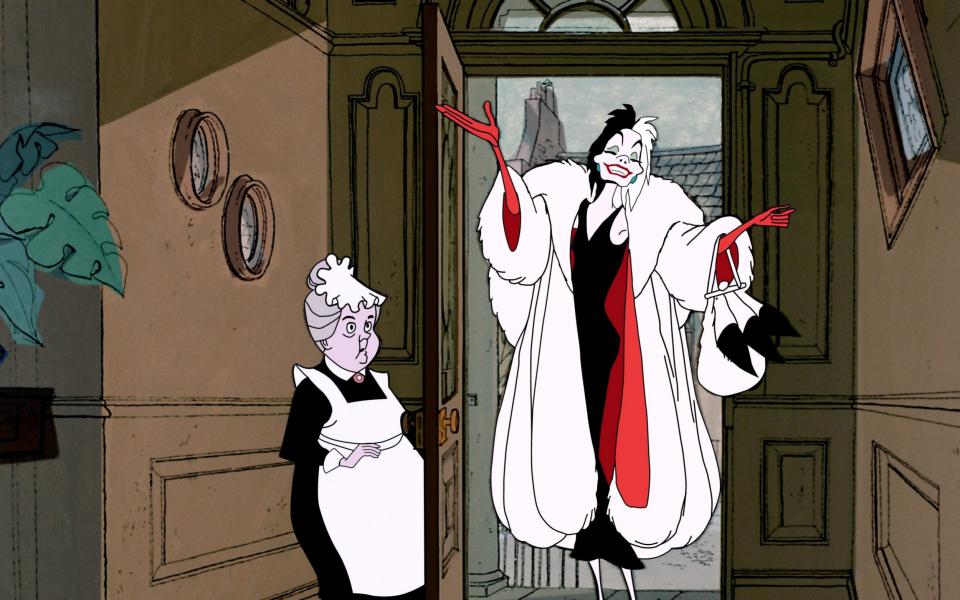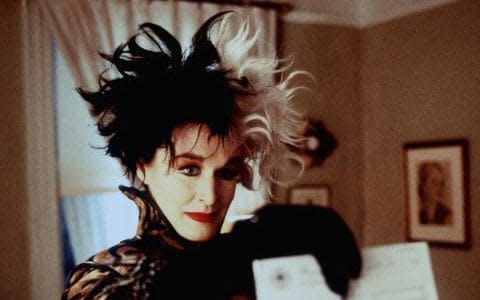Why the devilish origins of Cruella are too dark for Disney

- Oops!Something went wrong.Please try again later.
- Oops!Something went wrong.Please try again later.
- Oops!Something went wrong.Please try again later.
What turned grifting young fashion designer Cruella de Vil into a demented doggie-dispatcher? That is the question director Craig Gillespie’s new film Cruella sets out to answer. In recent years we’ve had cinematic origin stories for Hannibal Lecter, The Joker, and Maleficent (the witch in Sleeping Beauty). Now Hollywood is finally ready to tackle the wickedest fictional villain of all – if you measure wickedness according to the adorability of the villain’s proposed victims, that is.
Cruella depicts the early years of the ruthless puppy-napper from The Hundred and One Dalmatians. It will portray her as an aspiring designer, part of the punk scene in 1970s London. Perhaps her spiral into villainy will turn out to be the result of a Dalmatian chewing her Vivienne Westwood spiky stilettos.
The film aims to make us see Cruella, played by Emma Stone, in a more sympathetic light. “It’s hard to call someone a bad ’un completely when you see them from the very beginning,” Stone told Total Film recently. “I think by the time you get to the end of [this film], you start to understand how this narrative around Cruella developed.” Gillespie added that he wanted the audience to understand “her pain” and her “journey”.
When it comes to fictional villains, however, sometimes it’s best to follow John Major’s approach to the criminal classes: we “should condemn a little more, and understand a little less.” This is especially true of Cruella, whose appeal as a character lies in her irredeemable wickedness – we should be booing her non-stop every time she appears on screen.
The new film is the latest in a line of iterations of Cruella that take us a little bit further away every time from the character as conceived by Dodie Smith in her children’s story The Hundred and One Dalmatians (1956). Anybody who reads this wonderful little book – and if you haven’t done so for a year or 40, grab yourself a copy – can be left in no doubt that Smith did not intend us to feel an iota of sympathy for Cruella.
The real origin of Cruella de Vil can be traced to a chance remark made by the character actress Joyce Kennedy, who idly told Smith one day that her Dalmatian puppy, Pongo, “would make a nice fur coat”. At the time Smith was a star playwright, and had the idea of writing a children’s play about a woman who plots to start a fur farm with stolen Dalmatian pups, with Kennedy as the villainess.
Nothing came of it, but many years later, when Smith had fallen out of theatrical fashion, she decided to change direction and used the idea for her first children’s book. She called her dognapper Cruella de Vil – perhaps having rejected Satanica McEvilface as too subtle.
There are no shades of grey in the characterisation of Cruella. Her friend Christopher Isherwood complained that Smith made it too obvious in the book that she disapproved of Cruella: “One never should, of one’s villains”.

But it could not have been otherwise. Many of Smith’s books and plays warn of the dire consequences of wearing fur – fans of her other masterpiece, I Capture the Castle, will recall the farcical episode in which Rose receives karmic punishment for wearing a fur coat by being mistaken for an escaped circus bear. And she especially loved Dalmatians, ever since some friends presented her with a hatbox containing Pongo the pup for her 38th birthday; at one stage of her life she owned nine simultaneously. So in Smith’s eyes only a fiend could be capable of planning to kill Dalmatians for their fur.
Perhaps literally a fiend. There is a strong implication in Dodie Smith’s book that Cruella is some kind of genuine devil; that’s why she craves fur coats, to keep her warm during her Earthly sojourn away from hell.
She insists on huge fires – “such a blaze that the Dearlys thought the chimney would catch fire” – and puts excessive amounts of pepper on her food, including ice cream and fruit salad. One of the pups, Lucky, regrets nibbling her ear: “Don’t bite her, chaps! She tastes hot!” One of her ancestors is said to have had a long tail and the power to hurl lightning at his enemies (and it’s worth noting that “Count De Ville” was one of Dracula’s aliases in Bram Stoker’s novel).

Equally suggestive of her infernal origins are the levels of depravity she sinks to. At the beginning of the story, when she first meets the Dearlys’ Dalmatian puppies she is shocked that the “horrid little white rats” have no spots and insists: “You must drown them at once … It’d be quite easy. I’ve drowned dozens and dozens of my cat’s kittens. She always chooses some wretched alley-cat for their father so they’re never worth keeping.”
Later on, Cruella has the now-spotty puppies kidnapped and taken to her country house, Hell Hall, to be slaughtered by her henchmen: “I don’t care how you kill the little beasts. Hang them, suffocate them, drop them off the roof – good gracious, there are dozens of lovely ways. I only wish I’d time to do the job myself. … Here’s an idea for you: shut them up without food and then they’ll kill each other”. Luckily the puppies are rescued, partly thanks to the White Cat, who confirms that Cruella has drowned 44 of her kittens.
Needless to say, some of these nastier edges were smoothed away by Disney when it made the animation One Hundred and One Dalmatians (1961). The topics of canine cannibalism and kitten-drowning are not broached.

The Disney Cruella is certainly a fine creation but she lacks the menace of the character in the book. In Smith’s novel the soignée Cruella is introduced in a determinedly understated way: Mr Dearly calls her “a bit showy” and her black and white hair is “rather unusual”. In the film, however, we have a manically flamboyant Cruella who lacks the cool self-control of the character in the book, and allows herself to get carried away and crash her car while pursuing the puppies.
The Disney characterisation was partly based on the actress and good-time girl Tallulah Bankhead (the woman who first said: “I’m as pure as the driven slush”) and given an appropriately throaty and sometimes sensual voice by the actress Betty Lou Gerson. The senior animator, Marc Davis, told the Disney historian Brian Sibley: “I put something of all the bad women I’ve known into Cruella.”
The effect was to make Cruella a far camper and less frightening figure – a parody femme fatale – than the one in the book. This process continued with the live-action films of the 1990s, with Glenn Close bringing an amusing but lightweight mixture of burlesque sexuality and frenzied slapstick to her Cruella.

One notes also that in the book Cruella actually appears very little; as with Hannibal Lecter in The Silence of the Lambs, her appearance in a handful of scenes is enough to make her sulphurous presence infuse the whole of the story. I suspect that, also like Hannibal Lecter, she will diminish and become more two-dimensional the more her back story is fleshed out.
Where’s the fun in rationalising her evil and giving it a basis in her past, as Disney did with another of its villainesses in the unloved Sleeping Beauty prequel Maleficent? Real-life wrongdoers may be complicated, but books and films should be allowed sometimes to offer us figures that we can whole-heartedly hate.

